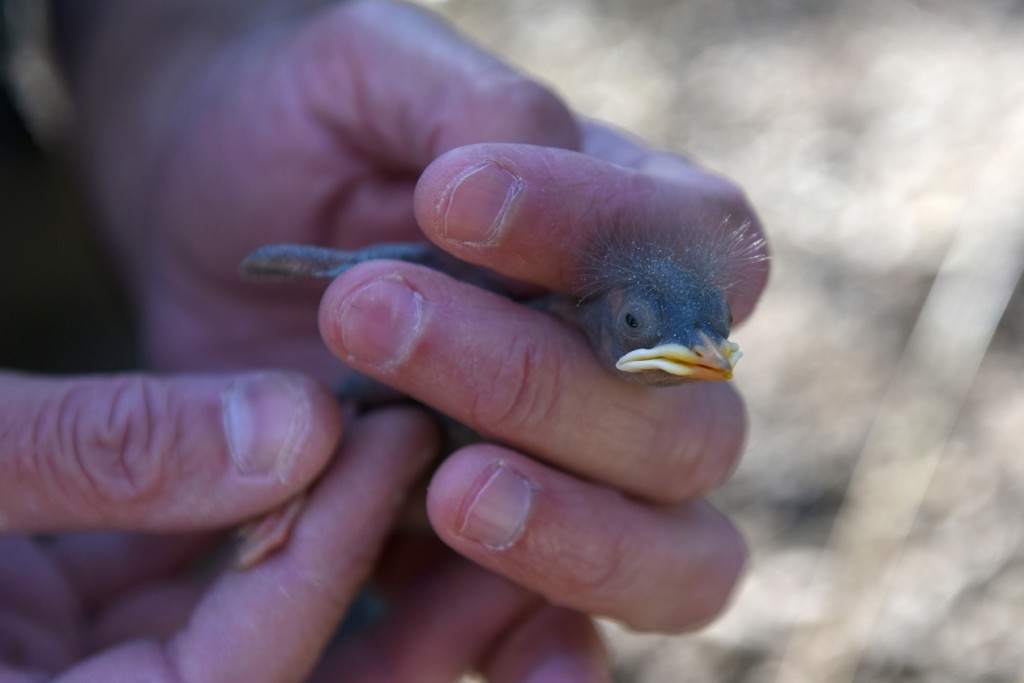Five pink and grey heads with punk rock hairdos, bright yellow beaks and beady black eyes blink into the light.
These dipper chicks have been temporarily removed from their nest and brought to the ground to be ringed, weighed and measured by Mike Nicoll of the British Trust for Ornithology.
Ringing aims to monitor the birds’ survival rates and collect information about their movements – information which provides vital support for conservation efforts and is the first step in reversing declines.
I’m honoured to be given the opportunity to get this close to the wild chicks but when Mike asks if I want to hold one of the eight-day-old dippers, I’m terrified I’ll either squash it or drop it.
Thankfully, I do neither, and the baby bird sits calmly in the palm of my hand while Mike and trainee ringer Andre Thiel weigh, measure and ring the bemused wee creature.
We’ve come to a bridge along the Dighty Burn with members of Dundee-based Dighty Connect conservation group in a bid to find a nest of young dipper chicks which Mike has been monitoring.
Putting on waders, we splash through the water and watch as Mike carefully removes the chicks from the nest, puts them into a small sack, and then temporarily stuffs up the nest with a bag. This is so that if the mother comes back, she doesn’t go in and worry the nest is empty, he explains.
Back on dry land, Mike and Andre weigh, measure and ring the dippers. They’ll return in a week to carry out the procedure again and put on different coloured rings which will indicate their birth site, age, and the river territory. This unique combination helps to identify the birds throughout their lives.
“We can handle the chicks until they are 16 days old and when they fledge the nest – at around 24 days – they often follow water courses and end up miles and miles away,” says Mike.
This particular nest on the Dighty was discovered by Mike in 2012 after another nest was washed away.
“Dippers particularly love making nests in tunnels, under bridges and in walls,” he says. “They love cliffs but they adapt well to man-made structures. If they were to nest on a smaller bank, they could be flooded out or eaten by rats and mink.”
The ringing, weighing and measuring only takes around 10 minutes and Mike deftly pops the chicks back into the nest before mum even notices they’ve gone.
Will she ever suspect her babies have been on a magical mystery tour? Mike suspects not. And what effect will the rings have on the birds?
“Ringing has little effect on birds because relative to the bird’s weight, wearing a ring is similar to a person wearing a watch,” he says.
“But it’s important that birds are not affected unduly by the fitting and wearing of a ring; if they were, ringing wouldn’t tell us how normal birds behave.”
Pootering about under the bridge, we see evidence of other wildlife. There are fox and otter footprints and scat (poo) in the mud, as project co-ordinator Jane Wilkinson points out.
“We do a lot of guddling about under bridges,” laughs Jane.
“But finding these dipper chicks is really exciting. Dippers are a good biodiversity indicator – by examining the birds and their territories, we can determine a lot about the health of the river, the water quality and abundance of insect life. It’s great to see where they go when they fledge and set up their own breeding territories.”
The dipper ringing project is part of what Jane calls “Citizen Science” and biological surveying. “It’s about getting local people involved in local science surveys to inform national organisations like the RSPB and the National Biodiversity Network,” she says. “It’s about finding out more about the state of the environment from a local perspective.
“Bringing together experts like Mike with local volunteers is like putting all the pieces of the wildlife jigsaw together, and it’s fascinating.”
info
Ringing is carried out by skilled ringers with the utmost consideration for the birds’ welfare and can only be learned by practice under the close supervision of experienced ringers.
Dighty Connect is a volunteer-led project working along the Dighty, exploring ways to enhance the green spaces along the burn through a mixture of conservation and cultural activities. As well as ringing dippers, the group survey bees, butterflies and other wildlife. They also create flower beds, river clean-ups and creating site-specific mosaic art. www.dightyconnect.org/












